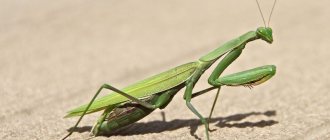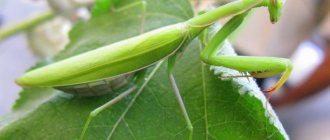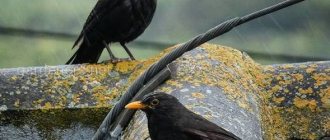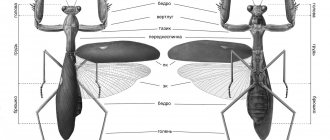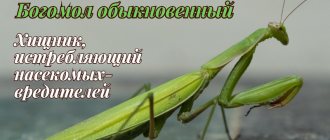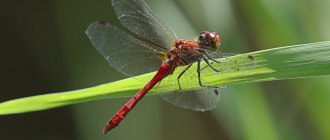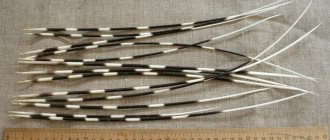The praying mantis is an arthropod insect that belongs to the order of praying mantises (lat. Mantodea, Mantoptera).
The origin of the international name "Mantodea" is not known with certainty. This detachment received its Russian definition due to some similarity between the insect's forelimbs and human arms bent at the elbow joint. In this position, the praying mantis is in ambush and waits for prey, shaking its head from time to time. Because of this behavioral feature, as well as due to associative perception, the insect, which resembles a person who reads a prayer, got its name.
Taken from the site: artfile.me
Mantis - description, structure, characteristics. What does a praying mantis look like?
Almost all praying mantises have an elongated body with a characteristic structure that distinguishes them from other arthropod insects. The movable head of the praying mantis has an almost triangular shape and is capable of rotating almost around its axis. Thanks to this, the insect can notice an enemy approaching from behind.
Photo credit: PiccoloNamek, CC BY-SA 3.0
The convex large compound eyes of the mantis have a complex structure and are located far from each other along the lateral edges of the head.
In addition to them, the insect has 3 simple eyes, which are located above the base of the antennae.
Photo credit: Luc Viatour / www.Lucnix.be, CC BY-SA 3.0
The antennae of the praying mantis consist of numerous segments and, depending on the species of the insect, are filamentous, feathery or comb-like.
The mouthparts of mantises are of the gnawing type and are directed downwards.
Thread-like antennae. Photo by: Fir0002, GFDL 1.2
Comb antennae. Photo credit: Raúl Baena Casado, CC BY 2.0
Feathery antennae. Author of the photo: Stas Shinkarenko
A characteristic feature of insects of this order is that the pronotum, widened in the upper part, almost never overlaps the head.
The soft, slightly flattened abdomen consists of 10 segments.
Photo credit: Luc Viatour / www.Lucnix.be, CC BY-SA 3.0
The last segment of the abdomen ends with long paired appendages of numerous segments, cerci, which are organs of smell.
In males, the cerci are better developed than in females.
Cerci and ovipositor of a female praying mantis Stagmomantis carolina. Photo credit: Kaldari, Public Domain
Almost all species of mantises have well-developed front and rear pairs of wings, thanks to which the insect can fly. It is noteworthy that the narrow and dense wings of the front pair serve as a kind of elytra that protect the hind wings. The rear pair of wings is wide, has many membranes and is folded like a fan.
Often the wings of a praying mantis are brightly colored or have a specific pattern on them. But there are also varieties of mantises that are completely devoid of wings and resemble larvae in appearance. This, for example, is the earthen mantis (lat. Geomantis larvoides).
Mantis Blepharopsis mendica. Photo credit: MathKnight and Zachi Evenor, CC BY 3.0
Praying mantis Tithrone roseipennis, Photo credit: Didier Descouens, CC BY 3.0
Earth mantis. Photo credit: Aemestrix
In the thoracic region of these insects, the front pair of limbs is especially well developed. Each of them consists of an elongated coxa, a trochanter, a femur, which is slightly longer in size than the coxa, a tibia, and a tarsus, consisting of 5 segments.
In its lower part, the thigh is studded with large sharp spines arranged in 3 rows, the drumstick also has spines, albeit smaller ones, and at the end of the drumstick there is a sharp needle-shaped hook. The last segments of the tarsi end in two rather large claws.
Along the entire length of the thigh there is a groove into which the shin is inserted, like the blade of a folding knife that retracts into the handle. Mantises capture their prey and hold it between the thigh and lower leg until the process of eating food is completed.
The middle and hind pairs of legs have a structure typical of arthropods.
Forelimbs of the praying mantis Otomantis scutigera. Photo credit: Bernard DUPONT, CC BY-SA 2.0
The circulatory system of mantises is quite primitively developed, which is a consequence of the way they breathe. The body is supplied with oxygen thanks to a complex branched system of tracheas, which are connected to spiracles (stigmas) lying on several segments of the abdomen, as well as located on the middle and posterior parts of the body. Expansions (air sacs) can form in the trachea, which increase ventilation of the entire respiratory system.
Sexual differences in mantises are quite pronounced and manifest themselves in the size of individuals: females are always much larger than males.
On the left is a female, on the right is a male common mantis. Left photo credit: Alvesgaspar, CC BY-SA 3.0. Photo on right: Nicolas Weghaupt, Public domain
Some mantises can reach a length of 17 cm, for example the species Ischnomantis gigas, which lives in Africa, or Heterochaeta orientalis, which is also called the oriental heterochaete and reaches a size of 16 cm.
Other mantises are very small in size and grow no more than 0.5-1.5 cm in length - such, for example, are the tiny mantises.
Taken from the website: www.deine-tierwelt.de
Baby mantis Armene pusilla. Photo by: togRa / Gracheva TO
The body color of the praying mantis depends on the environment, as it is camouflage in nature.
There are mantises that look like green leaves, flowers or sticks, while other species imitate tree bark, lichens, or even the black color of ashes after a fire.
The species Gonatista grisea is almost impossible to distinguish from the whitish growths on the tree. Photo by: Yaroslav Kuznetsov, CC BY-SA 4.0
Deroplatys lobata is very similar to the brown leaf. Photo credit: Fritz Geller-Grimm, CC BY-SA 3.0
Choeradodis rhombicollis resembles a green tree leaf. Photo by: Benjamint444, GFDL 1.2
Humbertiella sp. disguised as tree bark. Photo credit: L. Shyamal, CC BY-SA 3.0
It is unlikely that you will notice the praying mantis Pogonogaster tristani against a background of green moss. Photo credit: Leonardo Miranda Di Giambattista, CC BY-SA 3.0
Most praying mantises are green, yellow or brown, although there are species with brighter and more contrasting colors.
It is noteworthy that the colors of individuals of the same species can vary quite greatly, and also change after each molt.
Metallyticus splendidus shimmers in different colors and has a metallic sheen in color. Photo by: 김준석
Enemies of Mantises
When attacked by an enemy (snake, bird, bat or chameleon) or when meeting with a fellow rival, the mantises try to scare the enemy. They take a rather intimidating pose, spreading their wings like a fan, putting their front grasping legs forward and lifting the end of their abdomen up. This pose can be accompanied by threatening sounds. For example, the Sarawak mantis (lat. Hestiasula sarawaka) rustles its wings loudly and makes a clicking noise created by the contact of the upper part of the forelimb with the thigh. If the enemy turns out to be much stronger, the mantis prefers to retreat and flies away, however, seeing its advantage, it bravely confronts the enemy and often emerges victorious in such a fight.
Photo credit: CaPro, CC BY-SA 3.0
Where does the praying mantis live?
The distribution area of mantises is quite wide and covers almost all countries of Asia, Southern and Central Europe, as well as some countries in Africa and South America. It includes Spain, Portugal, Greece, Italy, Cyprus and Malta, Syria, India, China and Iran. Populations are found in Yemen and Turkey, Malaysia and Palestine, Saudi Arabia, Armenia, Azerbaijan and Israel. Some mantises live in Russia, Belarus, Tatarstan, Poland, and Germany. On merchant ships, these insects were brought and took root in Australia and North America.
In tropical and subtropical conditions, mantises live not only in humid forests, where they settle in the branches of trees or shrubs, but also in sun-warmed rocky deserts. In Europe, these insects are common in steppe regions, as well as in spacious meadows.
Praying mantises rarely change their habitat, and if potential food is present around them in sufficient quantities, they will never leave the selected plant or individual branch. Active movements are resorted to during the mating period, when there is a lack of food supply in the habitat or, in rare cases, when attacked by natural enemies: birds, chameleons, snakes or larger relatives. Almost all species of mantises lead a diurnal active lifestyle.
Photo credit: Andrew C, CC BY 2.0
What does a praying mantis eat?
The praying mantis is a predator and its diet usually consists of other small and large insects. Representatives of this order are not averse to feasting on gaping mosquitoes, flies, bees, wasps, bumblebees, butterflies, beetles or cockroaches. Large individuals can attack and eat small amphibians (lizards, frogs, geckos), small birds and even small rodents.
These predators attack their victims from ambush. They grab prey with their forelimbs and hold it until they completely eat it. Powerful jaws and the structure of the oral apparatus allow these insects to chew even large prey into pieces.
Photo credit: Luc Viatour, CC BY-SA 3.0
They are masters of disguise
Mantises are hunters, usually attacking from ambush. By nature they are well camouflaged. Insects come in the form of leaves, sticks and branches. For example, flower mantises look so convincing that unsuspecting insects come to collect nectar from them... and become lunch.
Photo: www.blog.prepscholar.com
Types of mantises, photos and names
There are more than 2,000 species of praying mantises. Below is a description of several varieties.
- Common praying mantis (Mantis religiosa)
Lives in most countries of Europe, Asia and Africa. Its distribution area includes Portugal and Spain, Italy and France, Turkey, Germany, Austria and Poland, as well as numerous islands of the Mediterranean Sea. This species is found in Sudan and Egypt, in Israel and Iran, as well as in Russia, from the southern regions to the Primorsky Territory. Introduced populations have been recorded in Australia and North America. The common mantis is a fairly large insect, measuring 4.8-7.6 cm in females and 4.0-6.1 cm in males. Individuals are colored green or brown with a yellow tint. The transparent wings of the praying mantis, trimmed with green or brown edging, are well developed. The rather long abdomen is ovoid in shape. A distinctive feature of this species is a black spot, which is located on both coxae of the front pair of legs on the inside. Often a light mark is visible in the center of such a spot.
Photo credit: Père Igor, CC BY-SA 4.0
- Chinese mantis (Chinese bowing mantis) (Tenodera aridifolia, Tenodera sinensis)
It is an endemic species that is naturally distributed throughout China. Adult female praying mantises reach 15 cm in length; males are much more modest in size. The color of these insects does not depend on gender and can be green or brown. Nymphs and juveniles lack wings. Chinese mantises acquire the ability to fly only after several molts. Tenodera sinensis exhibits vital activity at night. Life expectancy is 5-6 months.
Photo by: 池田正樹
- Praying mantis Creob r oter meleagris
Widely distributed in Bhutan, India, Nepal, Bangladesh, Vietnam, Laos, Pakistan and other countries in the South Asian region. Adults can reach 5 centimeters in length. The main body color of the praying mantis is cream or white. Light brown stripes of varying widths run throughout the body, head and paws. The elytra and pronotum are colored olive-green. On the elytra there is one small and one large spot of white or cream color. The larger spot has the shape of an ellipse, which is outlined in black at the top and bottom.
Taken from: www.nhm.ac.uk
- Praying mantis Creobroter gemmatus , also called Indian flower mantis
It is a typical inhabitant of the humid forests of India, Vietnam and other countries of South Asia. Mature males of this species of mantis reach a length of 38 mm, females are larger and grow up to 40 mm. The body of the insect is elongated, and the width of the pronotum is noticeably less than its length. There are several spikes of different heights on the hips. The body is colored cream with brown or greenish spots. Both pairs of wings are well developed, and on the upper pair, which acts as elytra, there is a large bright spot that resembles an eye with two pupils and serves to scare away predators. The wings of males are longer than those of females. Due to the fact that the lower wings of the mantis, colored pink and brown at the base, have numerous membranes, the impression of a bizarre scaly pattern is created. The insect lives in plant flowers, where it waits for prey during the day.
- Praying mantis Pseudocreobotra wahlbergii
Lives in areas with hot and humid climates. Other informal names for this insect are spiny or spiny flower mantis . This species lives in the countries of southern and eastern Africa: Kenya, Ethiopia, Tanzania, Zambia, Botswana, Zanzibar, Zimbabwe, Malawi, Namibia, South Africa, as well as Madagascar, Mauritius, Reunion. The size of adults is quite modest. The length of females does not exceed 40 mm, and males – 30 mm. The coloring of these mantises is heterogeneous - it combines white, cream, pinkish, yellow and green tones. On the upper pair of wings there is a rather interesting pattern, reminiscent of a green eye or a small spiral. It is noteworthy that the curls of these spirals on the right and left wings are directed towards each other. These insects have spines not only on the surface of the forelimbs, but also on the abdomen - hence the name of this mantis.
Taken from the site: media1.webgarden.cz
Taken from the site: media1.webgarden.cz
- Orchid mantis (Hymenopus coronatus)
Distributed in the tropical forests of India, Malaysia and Indonesia. This insect is considered one of the most beautiful representatives of the order. It received its name for its external resemblance to orchid flowers, on which it hides in anticipation of its prey. A sexually mature female praying mantis has quite impressive dimensions and grows up to 80 mm in length. The size of males is much more modest and does not exceed 40 mm. A distinctive feature of this species is its wide forelimbs, small head and thread-like antennae. The main body color of orchid mantises is white. However, it may vary depending on which flower the insect is lying in ambush. Various shades of pink, orange, yellow, lilac or purple can be mixed into the main tone. This type of mantis is characterized by increased aggressiveness. They can attack prey that is twice the size of the hunter. By the way, the larvae of the orchid mantis have a very unusual red and black coloring, which scares potential enemies away from them.
- Mantis Idolomantis diabolica , also called Devil's Flower or Devil's Flower
It lives in Ethiopia, Tanzania, Kenya, Somalia, Uganda and other countries of East Africa, where it lives on the branches of bushes and trees. Adult mantises of this species are quite large in size. Females can reach a length of 14 cm with a wingspan of about 16 cm. Male mantises are slightly smaller in size than females and rarely exceed 11 cm in length. The color of these insects can vary from various shades of green to light brown. The spines located on the thighs of the front legs have different lengths. Three shorter ones are visible between the long spines. A distinctive feature of this species is the characteristic leaf-shaped appendages formed by expanded cuticles, which are located on the back, as well as on the middle and hind limbs. In addition, unlike other species, in Idolomantis diabolica the top of the head tapers into a cone shape. Praying mantises of this species are often kept in home terrariums.
Taken from the site: archiwum.allegro.pl
- Eastern heterochaeta (Heterochaeta orientalis), which also has the informal name spiny-eyed mantis
Found in most African countries. The female mantis reaches 15 cm in length. Males are smaller in size and grow up to 12 cm. Due to the fact that these insects live in the branches of bushes, their appearance has unusual features that make them resemble twigs or twigs. In addition, these African mantises have spines located not only on the thighs and shins of the forelimbs, but also along the upper edges of the head, which is shaped like a triangle. This gives the impression that the insect's eyes are wrapped around these spines. This structure of the visual organs, combined with a long “neck” located between the head and prothorax, allows mantises of this species to easily notice prey or enemies not only in front and to the side, but also from behind. It is noteworthy that the insect’s body at this moment can remain completely motionless. The coloring of individuals depends on their age. If in the larval stage they are characterized by shades of brown, then the imago is characterized by light green shades.
Taken from the website: www.deine-tierwelt.de
Photo by: Aleania
- Praying mantis Empusa pennata
A species from the genus empusa, which is distributed throughout almost the entire territory of Africa, in most Asian countries, as well as in Portugal, Spain and Andorra, Monaco, Italy, Greece, Malta and Cyprus. Adult male praying mantises are slightly smaller than females, which grow up to 10 cm in length. A distinctive feature of the praying mantis is a peculiar high growth on its head, resembling a kind of crown in shape. Males have comb-type antennae, and the head is crowned with additional spines that look like feathers. The color of the praying mantis depends on the environment and can change. These insects are characterized by green, yellow or pink colors, as well as various shades of brown.
Photo credit: Redpit7, CC BY-SA 4.0
- Praying mantis Phyllocrania paradoxa
It lives in rather arid regions of Africa, located south of the Sahara Desert, as well as on the island of Madagascar, where it lives in the branches of bushes and trees. Thanks to its peculiar body shape, reminiscent of a plant leaf, it can easily hide from natural enemies and successfully hunt small insects. This camouflage is provided by special outgrowths on the body and head of the mantis. Moreover, the processes on the male’s head are rather curved and slightly thinner than those of the females. The adults of this species are quite small in size. Females grow to a maximum of 5 cm, males are smaller. Protective coloring varies depending on air humidity and temperature. If the air temperature is low and the humidity is high, the insects are green or gray-green in color. When humidity levels drop and temperatures rise, mantises turn brown or dark brown in color.
Photo credit: Mydriatic, GFDL
- Mantis Metallyticus splendidus
It lives in India, Malaysia, Sumatra and other countries in Southeast Asia. Hunts for prey in the branches of trees or shrubs, as well as under tree bark. Mature male mantises can reach a length of about 2 cm. Females are slightly larger and grow up to 3 cm in length. The body of these insects is slightly flattened from the back to the abdomen. Sexual dimorphism is expressed not only in size, but also in the color of individuals. Males are characterized by blue-green shades with a pronounced metallic blue tint. In females, the body is colored green with shiny bronze wing covers.
Photo credit: Notafly, CC BY-SA 3.0
- Praying mantis Ameles spallanziania
Widely distributed in Egypt, Sudan, Libya, Tunisia, Portugal, Spain, Italy, San Marino, Greece. The habitat of this species also includes Cyprus, Malta and other countries of Southern Europe and North Africa. The size of these insects is quite modest, with the length of males rarely exceeding 1 cm, and females can reach a length of 3 cm. You can also distinguish a male from a female by the presence of wings. If in males they are well developed and allow him to make fairly long flights, then in females this organ is reduced, so they are deprived of the ability to move through the air. The eyes of the praying mantis are conical in shape. The color of insects is variable and can vary from bright shades of green to brown and gray-brown. Unlike other species, these mantises have a short but strong hind limb.
Photo credit: Thomas Huntke, CC BY-SA 3.0
- The praying mantis Blepharopsis mendica , which also has the informal name thistle mantis
Found in Egypt, Sudan, Tunisia, Israel, Jordan, Iraq, Yemen and other countries in North Africa and southwestern Asia. These insects live in desert as well as mountainous areas. Males are slightly smaller in size than females, which can reach a length of 5.2-6.1 cm. In addition, the antennae of males have a comb structure. A distinctive feature of the species is also the characteristic growth on the top of the head. There are many spines of different sizes on the lateral surface of the thigh and lower leg. The color of individuals can be greenish or brownish with numerous white spots that merge into bizarre patterns.
Photo credit: Juan Emilio, CC BY-SA 2.0
- Praying mantis Rhombodera basalis
It lives in the tropical zone of Malaysia, Thailand and India. Adult females can grow up to 8-9 cm in length, males are slightly smaller. A characteristic feature of the praying mantis is its slightly enlarged pronotum, resembling a diamond shape. The body and wing covers of the insect are colored turquoise-green with a blue tint. The rear pair of membranous wings are partially colored in bright pink tones.
Photo credit: Luc Viatour, CC BY-SA 3.0
- Malaysian leaf mantis (Deroplatys dessicata)
Widely distributed both in the tropical forests of Malaysia or Indonesia, and in wet thickets in Sumatra and Borneo. Female Malaysian leaf mantises are much larger in size than males. Their length can reach 15 cm, while males grow to a maximum of 6 cm. This species has good camouflage abilities due to the special shape of the head and body, which give it a resemblance to withered foliage. Therefore, the color of the insect has a rather narrow color palette, including all shades of brown.
Photo credit: Adrian Pingstone, Public domain
- Mantis Deroplatys lobata
It lives in the rainforests of Malaysia, as well as in tropical thickets on the islands of Borneo and Sumatra. Prefers to hunt in the foliage of trees or small shrubs, as well as in their upturned roots. In appearance, these insects strongly resemble withered leaves, which serves them not only as an excellent camouflage that protects them from enemies, but also helps them hide and wait for prey. The color of the body and legs is uniform and can be different shades of gray or brown. Adult females grow up to 8 cm in length, while males barely reach 5 cm. Unlike females, males have developed wings, so they can fly, but females have lost this ability due to reduced wings.
Photo credit: Fritz Geller-Grimm, CC BY-SA 3.0
- Praying mantis Aethalochroa insignis
Lives in India. This is a very large insect, 15-20 cm long, including antennae. The praying mantis' excellent camouflage makes it look like a dry blade of grass.
Photo credit: Nnsolanki, CC BY-SA 4.0
Females prefer not to fly
For hours, and sometimes even days, the praying mantis sits without moving.
It fits perfectly into the environment, so the chance of noticing it is minimal. Despite its perfectly developed wings, the praying mantis moves very slowly, and if we talk about flying, it does it very poorly. A slowly flying insect, which can be seen from afar, is an easy prey for birds, so the praying mantis does not fly unless absolutely necessary, and females generally fly only in the most extreme cases - this is too risky . They are larger than males in size, and their wings are rather weak.
Reproduction of praying mantises
Mantises are characterized by development with an incomplete cycle of transformation, and besides, these insects have pronounced sexual dimorphism. Species of mantises living in tropical conditions are able to reproduce throughout the year. In the inhabitants of the temperate zone, the breeding season occurs in autumn.
Common praying mantises mating (green female and brown male). Photo credit: Zwentibold / CC BY-SA 3.0
Male praying mantises, using their sense of smell, begin searching for females ready to mate. Having found a suitable partner, males begin a ritual dance, which transfers them from the category of “potential food” to the rank of sexual partner. Usually, for the appearance of full-fledged offspring, the process of fertilization is necessary, although if the female receives enough nutrition, she can lay unfertilized eggs, from which single larvae (nymphs) may appear. The fertilization process often ends in the death of the partner: the female simply bites off his head and then eats him.
Scientists believe that this happens to improve the quality of fertilization on the part of the male, and the female also replenishes her reserves of nutritious protein substances for future offspring. True, not in all species the female praying mantis eats the male. Sometimes male praying mantises, who get away from their partner in time, avoid a sad fate.
Photo credit: Oliver Koemmerling, CC BY-SA 3.0
Some time after fertilization has occurred, the female praying mantis begins to lay eggs. Having secured itself on branches in the crown of trees (shrubs) or on tall, hard blades of grass, the female begins to squeeze eggs out of the ovipositor. At the same time, a special sticky secretion is secreted from special glands, which completely envelops the fertilized mantis eggs. Soon these secretions harden, resulting in the formation of a specific protective capsule called ootheca. Its length can reach 3 centimeters and width – 2.
Fecundity is determined by species: a female praying mantis is capable of laying from 10 to 400 eggs in one clutch. Depending on the environment, the color of the ootheca can vary from light yellow or greenish to brown or gray.
Ootheca of the common mantis. Photo credit: Kropsoq, CC BY-SA 3.0
Female mantises, which live in temperate latitudes with fairly cold winters, lay eggs in late September or early October. After some time, the females die, and the eggs enclosed in the ooteca easily tolerate unfavorable low temperatures.
Depending on climatic conditions, the egg stage lasts from three weeks to six months, after which larvae (nymphs) are born. Praying mantis larvae, crawling out of eggs, have nothing in common with adult individuals in appearance. Their body is completely covered with numerous small spines, the tip of which is directed from the head to the abdomen, which ends in two long “threads”.
Photo credit: Sarefo, CC BY-SA 3.0
Taken from the site: orchidcrazeme.blogspot.ru
Having made its way to the exit from the capsule, the young individual hangs from its outer side upside down, since the elastic edges of the exit hole of the capsule clamp the abdominal “threads”. It is in this position that the first molt occurs. The nymph immediately begins to live independently and is able to eat small insects. The development of the nymph occurs at a rapid pace, and, having survived another 4-8 molts in succession (depending on the species), the larva degenerates into an adult mantis.
Keeping praying mantises at home
Terrarium
Today, these interesting insects are kept as exotic pets in many countries. To keep praying mantises comfortably, you need a relatively small glass or plastic terrarium with a mesh lid, the dimensions of which must correspond to the size of the pet. It is necessary that the height of the dwelling is at least 3 times the length of the individual. Artificial branches or small living plants should be placed inside a transparent container, on which the insect will crawl, as in natural conditions. The bottom of the terrarium for the praying mantis is covered with finely chopped birch or oak leaves, sphagnum moss, crushed tree bark or coconut substrate.
Temperature
Almost all types of mantises are heat-loving insects, therefore, depending on the species, the temperature in the terrarium must be maintained between +23°C and +30°C. For heating, special heaters for terrariums are used, equipped with thermostats, or ordinary incandescent lamps placed on the side of the container, which can also be used as a lighting source. In any case, the temperature must be monitored using thermometers.
Taken from the site: antclub.net
Humidity
It should be remembered that humidity inside the terrarium is also important for praying mantises. Its indicators should be in the range of 40%-60%. To do this, once a day the plants and substrate must be sprayed with a spray bottle. In addition, you can install a small container of water inside your home. You need to control the humidity level using a hygrometer.
Mantis Compatibility
The praying mantis is a predatory insect, and if there is a lack of food, it can eat its neighbor, so it is better not to keep several individuals in one terrarium. Although some species from the empusa family may well coexist peacefully in the same territory.
What to feed praying mantises at home?
You should feed your domestic praying mantis only with live food. The size of insects included in a pet's diet depends on their age. Drosophila flies, small crickets, and aphids are suitable for feeding young praying mantises. Adults eat cockroaches, grasshoppers, locusts, flies and various larvae. Crickets as food are not suitable for all species. Some species are offered ants as food.
The domestic inhabitants of the terrarium need to be fed regularly. Nymphs are given food in small portions daily, but adult mantises need to be given food once every 2-3 days. The amount of food should correspond to the size of the pet, which should always be full. You should not give the praying mantis more than two insects at one feeding, although large individuals can be treated to three food insects. “Prey” intended for feeding can be launched inside the terrarium or given from tweezers.
Do praying mantises need water?
Mantises do not need to drink; they can easily get water from food. The insect also receives moisture by spraying water on the plants in the terrarium.
Photo credit: Happy1892, CC BY-SA 3.0
Turns head 180 degrees
The praying mantis has incredible abilities. His head is very mobile, equipped with keen eyes. This is the only insect that can turn its head 180 degrees in different directions , thus giving it a wide view (yes, many would dream of such an ability!)
In addition, despite the fact that mantises have only one ear, they hear everything perfectly, and thanks to the rotation of their heads, not a single future victim of the mantis will be able to escape from it...
Interesting facts about praying mantises
- In the fifties of the twentieth century, a program was developed in the Soviet Union, the goal of which was to use praying mantises to protect agricultural plants from pests. The attempts were unsuccessful, since in addition to them, the praying mantises also ate bees and other beneficial insects.
- In some regions of South Asia, praying mantises are bred to kill malarial mosquitoes and flies that carry infectious diseases.
- One of the styles of Chinese martial art, Kung Fu, was developed based on the movements of the front limbs of the praying mantis. The arsenal of this technique includes twelve basic movements that the praying mantis performs during hunting or defense against natural enemies.
- When attacking an enemy mantis that is larger than it, some species of these insects raise up the lower pair of wings, on which there is a pattern in the form of a huge eye. At the same time, they begin to make swinging movements, rustle their wings and rub the shin of the forelimbs on the surface of the thigh, making clicking sounds. If the act of intimidation does not bring results, the mantises may simply fly away or rush into a fight.
- The praying mantis insect is often mentioned in ancient myths or tales of Asian, African and European countries. The Greeks attributed to praying mantises the ability to predict the appearance of spring, but among the people of China they were the standard of stubbornness and greed.
Empusa striped. Photo credit: Gideon Pisanty, CC BY 3.0
Did you like the article? Share with your friends:
Can camouflage itself by changing color
The praying mantis is an amazing creature in every way! You can find both green and sand mantises... How do they change color? The fact is that the color of the insect is very variable - it varies from green to dark brown . Camouflage helps them adapt to the background, blending into it: be it earth or grass
. Praying mantises deftly merge with the surface on which they had to find themselves in the first days after the molting process. And finally, this happens in a brightly lit area.
